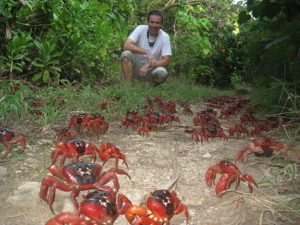
Ian Usher, author and public speaker, traveled to Christmas Island, Indonesia, just to watch red crabs exit en masse from underground burrows, during monsoon rains. But the experience may not be available for those who follow, without intervention by biologists. The red crabs’ existence has become endangered by an invader which forms huge colonies, and is spreading worldwide, threatening indigenous small animals and plants alike, from Australia to Canada.
The article below describes how biologists are fighting the invader to save the red crab, indigenous to Christmas Island in Indonesia, and shedding light on how the invader might be fought in other locations.
Named for the day it was discovered in 1643 and located a few hundred miles south of Indonesia, Christmas Island is home to around 45 million red crabs. Every year, these charismatic crustaceans—each about the size of your fist—crawl all over the 52-square-mile island and head to sea en masse to spawn. (This year’s migration began in early December.) People fly in from around the world to witness what resembles armies of cherry Christmas bulbs on the march.
It would seem no force could harry such a legion, armed as it is with claws and chitin. And yet, the crabs have a formidable enemy.
“One of the saddest sights to see on Christmas Island is a sea of dead red crabs on the forest floor,” says Dion Maple, natural resource manager for Christmas Island National Park. “You are looking at literally hundreds of thousands of dead and dying animals. It’s clear that the ecosystem is out of sync in these areas.”
What could possibly kill all those crabs? Crazy ants.
Sometime between 1915 and 1934, humans accidentally introduced yellow crazy ants to the island, an Australian territory in the Indian Ocean. By the 1990s, the ants started forming vast super-colonies with millions of workers and thousands of queens. According to Maple, one super-colony found in 2002 covered nearly 1,900 acres. Scientists call the crazies “unicolonial,” meaning their colonies do not attack each other. Everything else that moves is fair game, though, and on Christmas Island, that means a lots of crabs.
Research conducted by scientists at La Trobe University in Melbourne, Australia, suggests that, since the 1990s, the ants have killed tens of millions of crabs, and this has sent shock waves through the island’s ecosystem.
Red crabs eat leaf litter. A forest inhabited by the crustaceans looks like a well-kept parlor, with nary a twig or sprig out of place. But when yellow crazy ants move in, they swarm over the crabs, spraying the crustacean’s eyestalks and leg joints with formic acid. This blinds and immobilizes the crabs, dooming them to death by dehydration—or worse, being torn limb from limb by the ants’ pincers.
Without the crabs, leaf litter builds up, creating a dense mat on the forest floor. Seedlings and saplings take root. Within a matter of months, what was once a sparse understory turns into a thicket of new growth. Dirt tunnels the crabs once maintained eventually collapse, removing hideaway habitat for other creatures. Soil that was tilled by the crabs’ busywork gets compacted. Worst of all, biodiversity plummets as the forest becomes “devoid of life other than that of the crazy ants,” Maple says.
And that’s just at ground level. To understand the true impact of the crazy ants’ reign, you have to look up.
You see, yellow crazy ants can’t form super-colonies without an enormous and steady supply of resources. And one way to ensure this is to ally your army with another insect, one that happens to squirt liquid gold out of its butt—er, abdomen.
Yellow lac scale insects are armored, immobile tree parasites that are also not native to Christmas Island. Like tiny vampires, they anchor themselves to a tree branch and suck out sap, eventually emitting a sugary-sweet waste product called honeydew that the crazies go, well, crazy for.
Honeydew provides the ants with a steady source of carbohydrates and helps their colonies swell to the size of small cities. (The crazy-big colony mentioned above would be about four times the size of downtown Pittsburgh.) In return, the ants protect the scale insects by cleansing the habitat of predators, enabling the parasites to proliferate. Maple says that too many scales can have dire consequences for even the largest of forest trees. “Hundreds of thousands of scale insects can stress the tree to the point where it defoliates. Over multiple seasons this ongoing and relentless stress can kill it.”
To read about how scientists are combatting this invasive species on Christmas Island, see the rest of this article at psmag.com
The featured picture of Ian Usher observing the march of the red crabs during the Monsoon on Christmas Island was taken from his own work posted on Wikimedia Commons.



